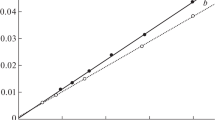Summary
The solubility parameter concept is briefly discussed. It is then used to explain some of the current features of liquid partition and adsorption chromatography. Various phase systems are discussed on the basis of three characteristics.retention, selectivity (the general separation power of a system) andspecificity (increased separation power towards certain pairs of solutes). The emergence of two essentially different techniques, the ‘normal phase’ and ‘reversed phase’ modes, will appear as a logical consequence of simplified theory. It also becomes obvious why ‘reversed phase’ applications are so much more numerous. Some suggestions are given for the development of new stationary phases and the improvement of existing ones. The usefulness of the solubility parameter concept to predict the solvent strength of mixed eluents in reversed phase liquid chromatography (RPLC) is demonstrated. Some practical rules for the selection and operation of stationary and mobile phase systems are formulated.
Similar content being viewed by others
References
L. R. Snyder, J. Chromatogr.92, 223 (1974).
L. R. Snyder, J. Chrom. Sci.16, 223 (1978).
R. McCormick, P. J. Schoenmakers, B. L. Karger, IV th International Symposium on Column Liquid Chromatography, Boston, 1979.
C. Horváth, W. Melander, I. Molnár, J. Chromatogr.125, 129 (1976).
C. Horváth, W. Melander, I. Molnár, Anal. Chem.49, 142 (1977).
R. A. Keller, B. L. Karger, L. R. Snyder, in: “Gas Chromatography 1970”,R. Stock (Ed.), Institute of Petroleum, London 1971; p. 125.
B. L. Karger, C. Eon, L. R. Snyder, J. Chromatogr.125, 71 (1976).
B. L. Karger, L. R. Snyder, C. Eon, Anal. Chem.50, 2126 (1978).
R. Tijssen, H. A. H. Billiet, P. J. Schoenmakers, J. Chromatogr.122, 185 (1976).
J. H. Hildebrand, J. M. Prausnitz, R. L. Scott, “Regular and Related Solutions”, Van Nostrand Reinhold, New York, 1970.
H. G. Harris, J. M. Prausnitz, J. Chrom. Sci. 7, 685 (1969).
P. Alessi, I. Kikic, G. Torriano, J. Chromatogr.106, 17 (1975).
A. F. M. Barton, Chem. Rev.75, 731 (1975).
P. J. Schoenmakers, H. A. H. Billiet, R. Tijssen, L. de Galan, J. Chromatogr.149, 519 (1978).
P. J. Schoenmakers, H. A. H. Billiet, L. de Galan, J. Chromatogr.185, 179 (1979).
H. Colin, C. Eon, G. Guiochon, J. Chromatogr.119, 41 (1976); ibid.H. Colin, C. Eon, G. Guiochon, J. Chromatogr.122, 223 (1976).
H. Colin, G. Guiochon, J. Chromatogr.137, 19 (1976).
K. K. Unger, P. Roumeliotis, H. Mueller, G. Goetz, J. Chromatogr.202, 3 (1980).
E. Smolková, J. Zima, F. Dousek, J. Jansta, Z. Plzák, J. Chromatogr.191, 61 (1980).
A. V. Kiselev, Discuss. Faraday Soc.40, 228 (1964).
G. E. Berendsen, K. A. Pikaart, L. de Galan, C. Olieman, Anal. Chem.52, 1990 (1980).
P. J. Schoenmakers, H. A. H. Billiet, L. de Galan, J. Chromatogr.218, 261 (1981).
C. Hansen, A. Beerbower, in: “Kirk-Othmer encyclopedia of chemical technology”, 2nd edition, suppl. vol., New York, 1971; p. 889.
J. D. Crowley, G. S. Teague, J. W. Lowe jr., J. Paint Technol.38 (496), 269 (1966);39 (504), 19 (1967).
E. B. Bagley, T. P. Nelson, J. M. Scigliano, J. Paint Technol.43 (555), 35 (1971).
E. B. Bagley, T. P. Nelson, J. W. Barlow, S.-A. Chen, I. & E. C. Fund.9, 93 (1970).
E. B. Bagley, T. P. Nelson, S. A. Chen, J. W. Barlow, I. & E C. Fund.10, 27 (1971).
I. A. Wiehe, E. B. Bagley, A. I. Ch. E. Journ.13, 836 (1976).
F. London, Z. Physik. Chem.B11, 222 (1930).
F. London, Trans. Faraday Soc.33, 8 (1937).
C. J. F. Böttcher, “Theory of electric polarization”, Elsevier, Amsterdam, 1952 (1975).
H. Colin, N. Ward, G. Guiochon, J. Chromatogr.149, 169 (1978).
P. J. Schoenmakers, H. A. H. Billiet, L. de Galan, J. Chromatogr.205, 13 (1981).
H. A. H. Billiet, P. S. Schoenmakers, L. de Galan, J. Chromatogr.218, 443 (1981).
Author information
Authors and Affiliations
Additional information
Main author.
Rights and permissions
About this article
Cite this article
Schoenmakers, P.J., Billiet, H.A.H. & de Galan, L. The solubility parameter as a tool in understanding liquid chromatography. Chromatographia 15, 205–214 (1982). https://doi.org/10.1007/BF02261542
Received:
Accepted:
Issue Date:
DOI: https://doi.org/10.1007/BF02261542




